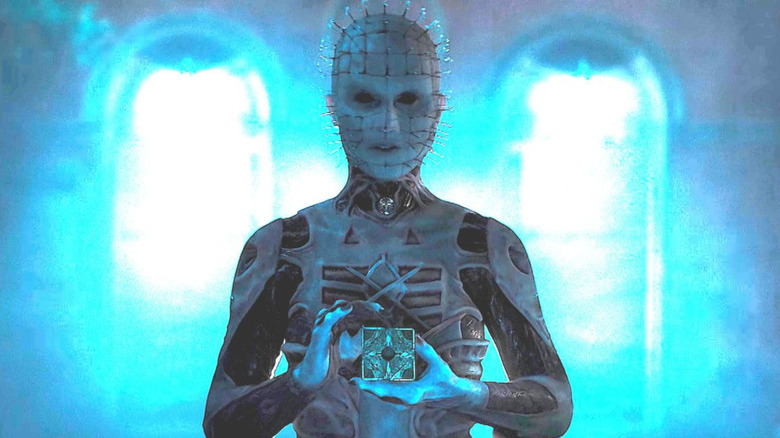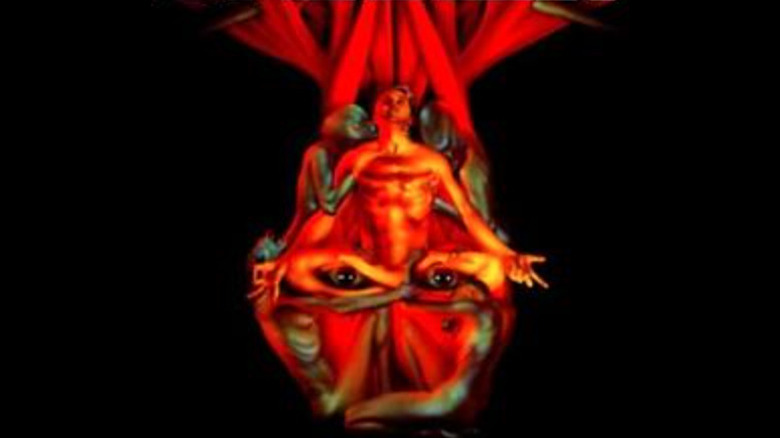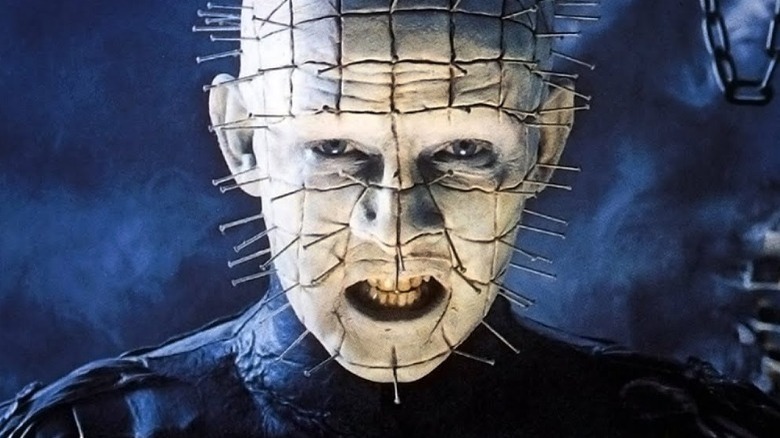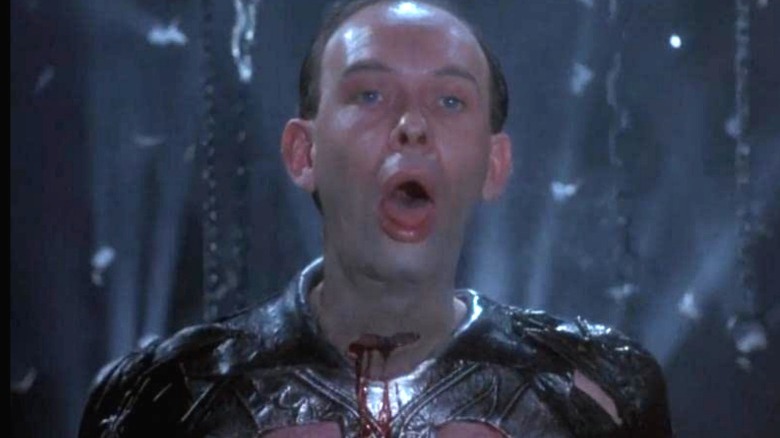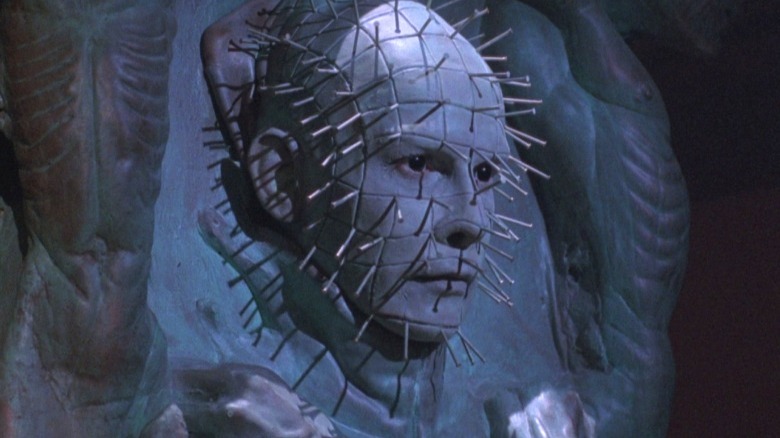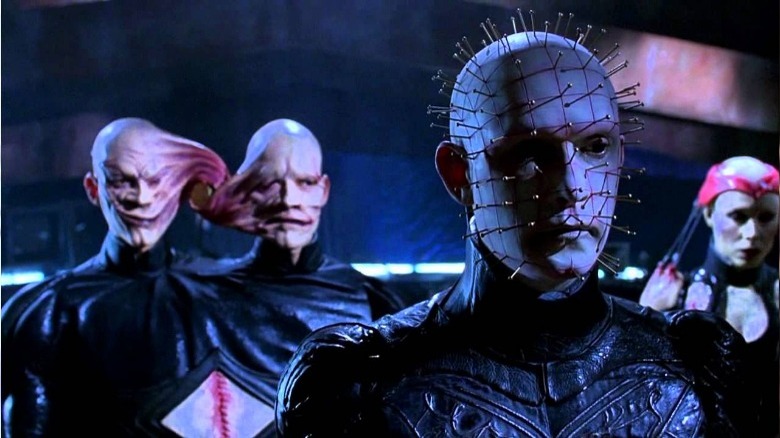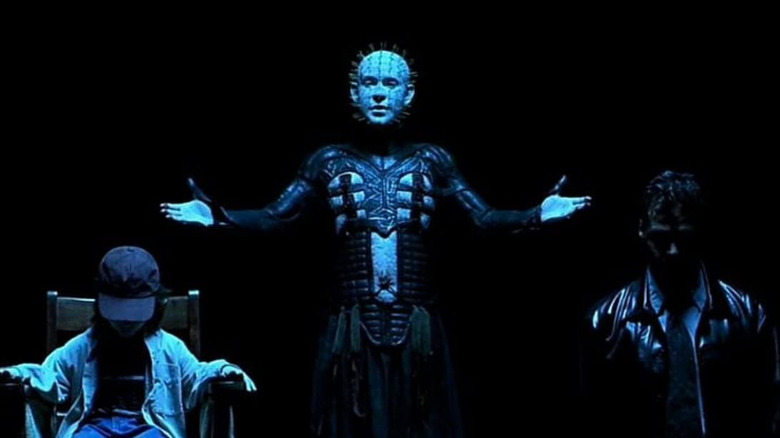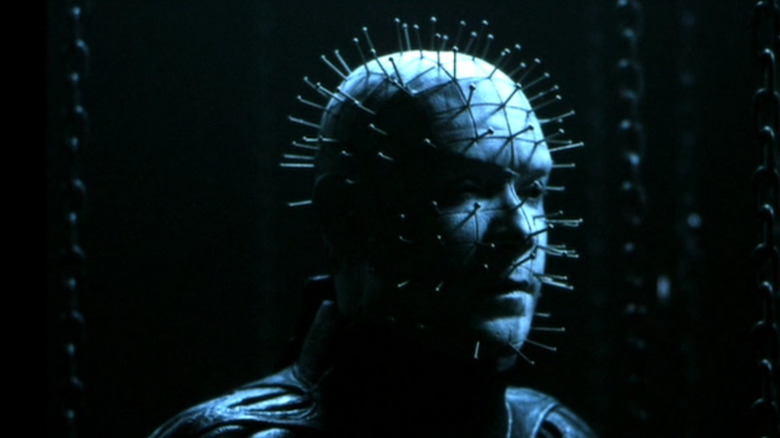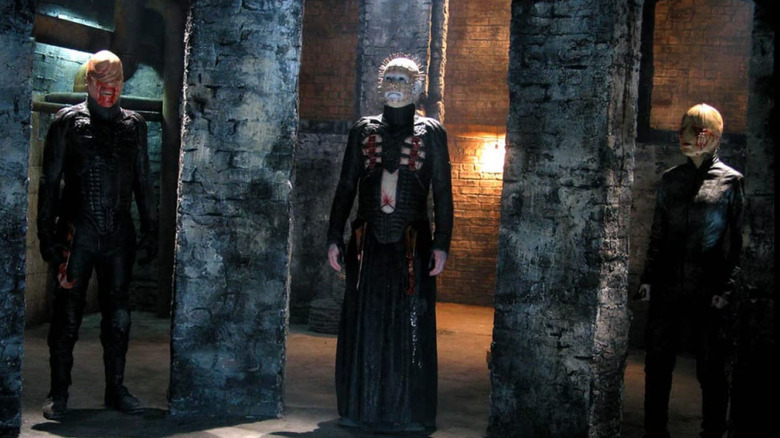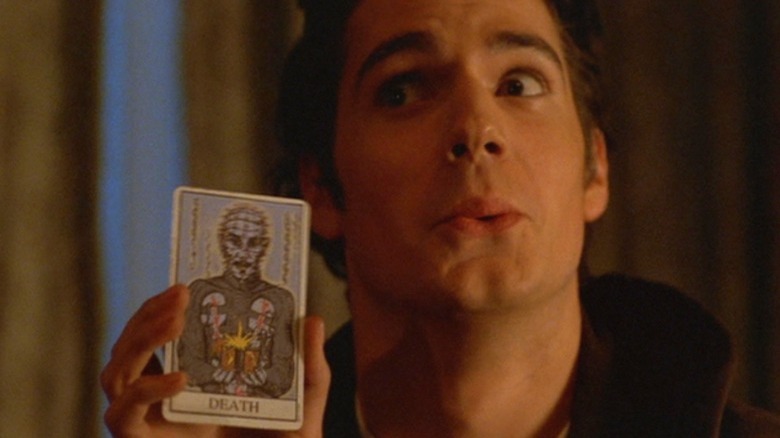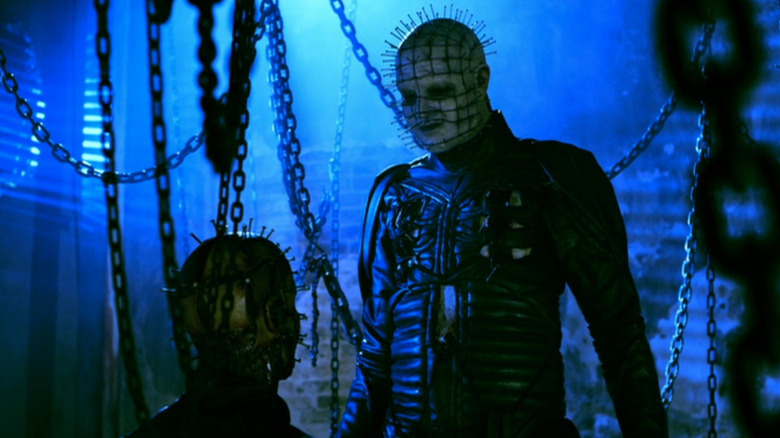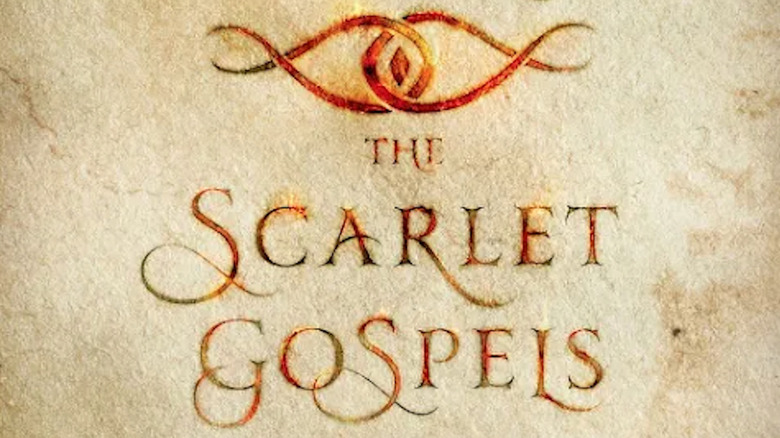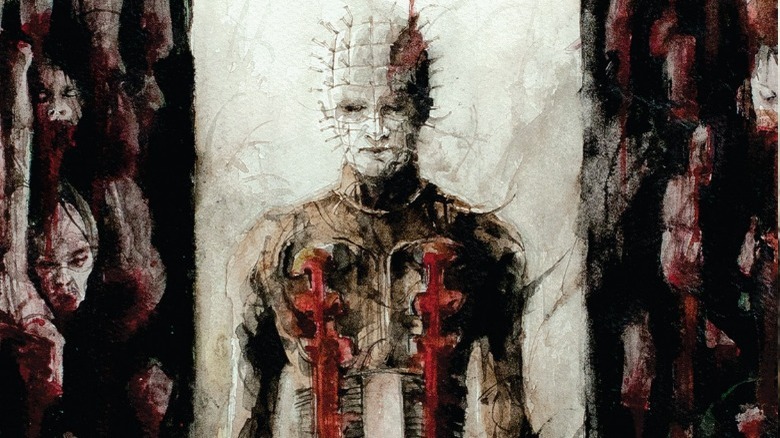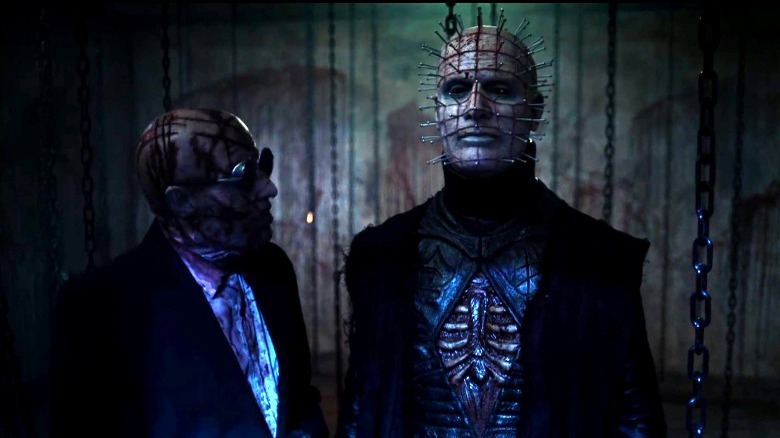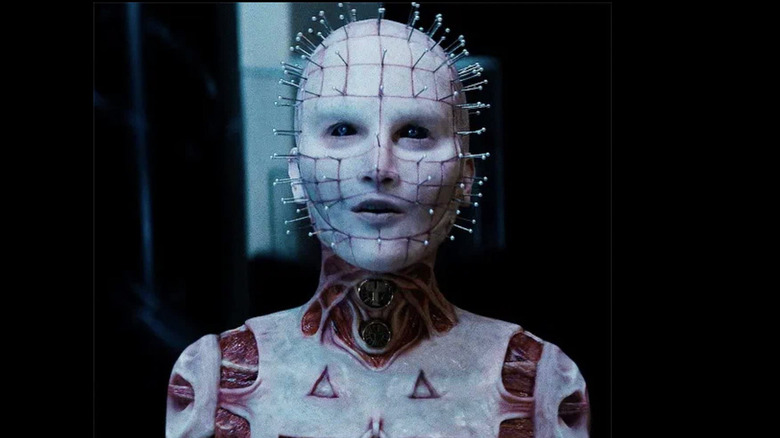The Evolution Of Pinhead From 1986 To 2022
In 1987, Clive Barker's demented love story "Hellraiser" hit theaters and forever changed the horror landscape. Adapted from his novella "The Hellbound Heart," Barker's film is a horrifying tale of hellish temptations and forbidden pleasures.
Despite being a minor character in the books, "Hellraiser" and its 10 subsequent sequels are best known for introducing the world to the extra-dimensional being known as Pinhead. Officially called the Hell Priest, this entity is intrinsically linked to an ornate puzzle box named the Lament Configuration. Pinhead and his Cenobite colleagues emerge from a hell-like dimension to claim the soul of anyone who solves the puzzle, dooming them to an eternity of torture. Inspired by the Dutchman, a character in one of Barker's early plays, Pinhead's evocative design and urbane demeanor has made him one of the most frightening and fascinating figures in all of horror.
Thirty-five years after the first film in the series, a new adaptation of Barker's original story has emerged. David Bruckner's reboot, also called "Hellraiser," offers a new take on the Lament Configuration's lore as well as a new batch of Cenobites for the box to summon. They're led by a dangerously beautiful new Hell Priest, played by Jamie Clayton, who brings the memorable character even closer to her creator's original designs. To fully appreciate this return, let's look back at how Pinhead has evolved, first from the page to the screen, then to direct-to-video releases, then back to the page again, and, finally, into the hierophant that Barker originally envisioned.
The Hellbound Heart (1986)
Clive Barker's novella "The Hellbound Heart" introduces readers to the Cenobites in its opening pages. While many believe that the Hell Priest is the "Hellraiser" series' central villain, Barker's original story is more concerned with a lecherous man named Frank who becomes ensnared in the box's magic and recruits his lover, Julia, to help him escape. The Cenobites are a fairly insignificant part of the story, and only appear when summoned by Frank in the opening chapter, and when they try to collect their escaped prisoner a little bit later.
Barker's novella introduces four Cenobites, with no clear leader among them. Each is described in graphic detail, and it's not until we read the following passage that we can identify the monster we will come to recognize as Pinhead. "Every inch of its head had been tattooed with an intricate grid," Barker writes, "and at every intersection of horizontal and vertical axes a jeweled pin driven through to the bone. Its tongue was similarly decorated." Barker's text describes the Hell Priest with more gender fluidity than most of the films, writing, "Its voice, unlike that of its companion, was light and breathy — the voice of an excited girl." Here, the true leader of the Cenobites is an entity known as the Engineer, a shapeless form who will be summoned "should the moment merit."
Hellraiser (1987)
Tired of directors who didn't understand how to bring his work to the screen, Clive Barker decided to take matters into his own hands and direct the cinematic adaptation of his novella "The Hellbound Heart" himself. Regarding Pinhead's design, in the liner notes for a "Hellraiser" DVD set (via Barker's personal website), Barker said, "I had seen a book containing photographs of African fetishes: sculptures of human heads crudely carved from wood and then pierced with dozens, sometimes hundreds, of nails and spikes. They were images of rage..."
Barker also credits a visit to Cellblock 28, an underground club in New York City, as inspiration for the Cenobites. Referring to the sadomasochistic elements of the Hell Priest's design, Barker told The Guardian, "I got a good reaction from the S&M crowd — and still do. I was validating a lifestyle. It was a celebration of the beauty of these strange secret rituals."
Surprisingly, Doug Bradley almost rejected the role that would make him famous. As a new actor, he was nervous that he would be unrecognizable under the heavy makeup. Describing his first experience in costume, Bradley said, "The first time I wore it, I sat in front of the mirror trying to make friends with this new face, playing some lines and seeing where they took me. Most of my decisions about playing Pinhead were made there and then ... His threat is implied: look what I did to myself – now imagine what I can do to you."
Hellbound: Hellraiser II (1988)
The second film in the "Hellraiser" series deepens the lore behind its central antagonist by giving the lead Cenobite a sort of origin story. The film begins in a dark bunker as a British soldier named Elliot Spencer opens the sinister puzzle box. After he discovers the solution, we see his painful metamorphosis into the monster we will come to know as Pinhead.
Doug Bradley plays Spencer as well as Pinhead, giving the talented actor a chance to show his real face to audiences. This adds some (literal) humanity to the Hell Priest's mysterious character, and offers a new perspective on the order of Cenobites, presenting them as disciplines of an ancient order. In Fangoria (via Clive Barker's website), Bradley explained, "I don't see him as the first Cenobite. Of the four we know about, he is the leader, but the Cenobites have been around for centuries. To me, Pinhead is the chief Cenobite of the 20th Century."
Having established the series' central tone and aesthetic sense in the first film, Barker passed directorial duties to Tony Randal for the sequel. However, Barker did write the story for "Hellbound: Hellraiser II," which Peter Atkins turned into a screenplay. As in the first film, Pinhead is neither the star nor the central villain. While defending Kirsty (Ashley Laurence) from a malevolent new Cenobite, Pinhead reverts to his human form and seemingly sacrifices himself so that she can escape.
Hellraiser III: Hell on Earth (1992)
The third installment in the franchise, "Hellraiser III: Hell on Earth," takes Pinhead in a new direction. It's the first film without heavy involvement from creator Clive Barker, but Doug Bradley recalls intense conversations with screenwriter Peter Atkins about the evolution of the character. He told Fangoria, "We've really discovered who this demon is and, equally as important, who he was as a human being."
The third film begins with Elliot Spencer (Bradley) trapped in limbo. Separating humanity from the Cenobite has freed Pinhead from Hell. He is now trapped in an intricately carved sculpture called the Pillar of Souls, which is purchased by nightclub owner J.P. Monroe (Kevin Bernhardt). Like Julia before him, Pinhead charges Monroe with delivering souls to Pinhead so that he can devour them and free himself. Only by fusing Spencer's soul with Pinhead's body can they return this killer to his otherworldly confines.
As Barker told the New York Daily News, "'Hellraiser III' is definitely Pinhead's movie." Atkins, meanwhile, sees this film as a liberation of sorts for the famous monster, saying, "It's very much an examination of the rules of Hell, and by freeing Pinhead from those rules, we discover more about him. You could call this 'Pinhead Unbound.'" This film also marks the first time that the Hell Priest is presented as a legitimate villain. In earlier movies, he's only a danger to those who open the box or otherwise find themselves in Hell. Once freed, however, this version of the Hell Priest goes on a killing spree, massacring club-goers and turning innocent victims into an army of Cenobites.
Hellraiser: Bloodline (1996)
"Hellraiser: Bloodline" sees the franchise take its biggest creative swing, as well as Pinhead's official death. The film begins and ends among the stars as a distant relative of Phillip Lemarchand (Bruce Ramsay), the French craftsman who created the puzzle box, attempts to close the portal to Hell by destroying Pinhead and the Lament Configuration in a space station designed specifically for the task.
This film also sees a clarification of Pinhead's philosophy. Although he joins forces with a demon princess named Angelique (Valentina Vargas), Pinhead finds himself at odds with her over her preferred method of torture: seduction. Describing this tension, a returning Doug Bradley said, "This is something entirely new for Pinhead; he's never had a demonic cohort, so to speak ... Angelique is at least his equal, and certainly in Angelique's own mind, possibly his superior. Pinhead doesn't quite see things that way, so their relationship is a little sparky."
Though only involved in devising the broad strokes of the story, Clive Barker reportedly contributed the last line that Bradley speaks as the theatrical version of Pinhead. At a 2006 "Hellraiser" reunion panel, writer Peter Atkins remembered, "The last line was just a free gift from Clive, so I thought it was very fitting that the guy who created the whole thing in the first place wrapped it up. And the line is: 'I am so exquisitely empty.'"
Hellraiser: Inferno (2000)
As the "Hellraiser" franchise became a direct-to-video series, Pinhead's characterization began to shift. "Hellraiser: Inferno" follows Joseph (Craig Sheffer), a corrupt detective who finds and solves the Lament Configuration after finding the box at a crime scene. Pinhead (Doug Bradley) does not appear until the end of the film, which contains the revelation that Joseph has been in hell all along. His therapist, Dr. Gregory (James Remar), is actually the Hell Priest in disguise.
This marks the first time that the entity known as Pinhead appears disguised as another human. It also contradicts the previous film, "Hellraiser: Bloodline," in which Pinhead is staunchly opposed to relying on manipulation and temptation to torture his subjects. We will continue to see this kind of mental torment later in the franchise, but this entanglement marks an early example of how the "Hellraiser" mythology becomes increasingly muddled with each new installment.
Bradley is not a fan of "Hellraiser: Inferno" or this change for the character. In a 2007 interview with IGN he said, "There was a kind of moralistic tone that crept up that I didn't approve of at all." Clive Barker also doesn't care for the film, especially the depiction of Pinhead, telling the Lost Souls Newsletter, "What I'm trying to do is give the guy a decent dignified send-off. It's really important to me, and I think he's a great monster. I really hate the way he's been treated in this film."
Hellraiser: Hellseeker (2002)
"Hellraiser: Hellseeker" is notable for the return of the original film's final girl, Kirsty (Ashley Laurence), but otherwise it essentially recycles the plot of "Hellraiser: Inferno." Again, the film follows a corrupt husband who realizes by the end of the film that he's actually been trapped in Hell, and is being punished by Pinhead (Doug Bradley) for crimes he committed while he was alive. Though he has a more prominent role, Pinhead doesn't actually appear until the final act, when Trevor (Dean Winters) realizes that the body on the table is not his dead wife's but his own.
Screenwriter Tim Day recounts having a hard time getting Laurence, who exited the franchise after cameoing in the third film, to sign on to the project. He says it was actually Bradley himself who convinced her. As Laurence recalled in Cinescape (again, via Clive Barker's website), "I got a call from Doug Bradley at home, and kind of out of the blue he said that he was doing 'Hellraiser' and that the director was talking about the fact that he would love to bring back the Kirsty character in a cameo."
Despite this rehashed plot, "Hellraiser: Hellseeker" presents an interesting shift in Pinhead's methods and motivations. In a return to the original source material, Pinhead becomes fixated on capturing Kirsty, who escaped the Cenobites in the original film. To save herself, Kirsty brokers a deal with Pinhead, offering up five different souls in exchange for her own.
Hellraiser: Deader (2005)
The lackluster "Hellraiser: Deader" sees Pinhead battle a rival for control of the Lament Configuration. A Romanian cult leader known as Winter believes that his distant relationship to the creator of the puzzle box gives him control of the Cenobites. Unwilling to open the box himself, Winter (Paul Rhys) enlists followers who are suffering from mental illnesses, and convinces them to die by suicide. He then reanimates them and adds them to his cult, which is known as the Deaders. Pinhead only appears in the final act to confront the human who would dare to challenge his authority.
This confusing script is the first example of a problem that would come to plague the franchise. As screenwriter Tim Day told Fangoria, "We've taken a script called 'Deader' that Neal Marshall Stevens sold to Dimension almost two years ago as a spec, and I've rewritten it to incorporate the 'Hellraiser' mythology." This is probably why Pinhead feels like an afterthought. Stevens more or less confirmed as much, saying, "Pinhead has been brought in as an additional character. As in most recent 'Hellraiser' movies (from what I hear — I haven't seen them), he does not have a large part." Despite the reduction of his role, Doug Bradley was still enthusiastic about returning to the character, saying, "I'm still enjoying doing the movies, still having fun doing them, still finding fresh territory to explore myself."
If you or someone you know needs help with mental health, please contact the Crisis Text Line by texting HOME to 741741, call the National Alliance on Mental Illness helpline at 1-800-950-NAMI (6264), or visit the National Institute of Mental Health website.
If you or anyone you know is having suicidal thoughts, please call the National Suicide Prevention Lifeline by dialing 988 or by calling 1-800-273-TALK (8255).
Hellraiser: Hellworld (2005)
Like "Hellraiser: Deader," the final film featuring Doug Bradley as Pinhead was not originally planned as a "Hellraiser" film. "Hellraiser: Hellworld" was filmed in Romania immediately after its predecessor as a part of a two-picture contract with Dimension Films. However, the deal was inked before anyone had begun writing a script for the second movie, and producers scrambled to find a workable treatment that they could quickly spruce up with some "Hellraiser" mythology. As a result, the film is an adaptation of a short story by Joel Soisson called "Dark Can't Breathe," and is more indebted to "Scream" than Clive Barker's original movie.
Here, Pinhead and the Cenobites exist as fictional characters who have been incorporated into a massively multiplayer online role-playing game called "Hellworld." A group of teens who are addicted to the game attend a private "Hellworld" party thrown by a mysterious host (Lance Henriksen). One by one, they fall victim to the Cenobites; however, it's eventually revealed that they've actually been buried alive by the host as revenge for his son's death. Their murders at the hands of the Cenobites are simply drug-induced hallucinations. It's not until the end of the film that the host finds the Lament Configuration among his son's possessions, and that Pinhead and the Cenobites appear in earnest, dutifully tearing their next victim's soul apart.
Hellraiser: Revelations (2011)
"Hellraiser: Revelations" follows two college students on a debauched road trip that leads them to the legendary Lament Configuration. The boys promptly disappear, and their families struggle to piece together the events of their final days.
Rushed into production so that Miramax could maintain the rights to the franchise, director Victor Garcia was given a mere 10 days to prepare and only two weeks to shoot. Due to this tight timeline, Doug Bradley refused to participate in the project, stating, "The ink is barely dry on the script, and it is scheduled to be in front of the cameras in two weeks time and in the can by the middle of next month. The miniscule shooting schedule is more than matched by the budget." Clive Barker also disavowed the project in a profanity-riddled tweet.
With Bradley's absence, Garcia had two choices: omit the franchise's most well-known character, or cast another actor to play Pinhead. He opted for the latter, and Stephan Smith Collins stepped into the robes of the infamous Hell Priest. Though not an enviable position for any actor, Taylor feels all wrong for the role, losing the austerity and still menace that Bradley had perfected. Voiced by Fred Tatasciore, this Pinhead feels like a cheap approximation of the character. In the end, it's difficult to disagree with Bradley's summation that "Hellraiser: Revelations" "does not seem ... to represent a serious attempt to revive the "Hellraiser" franchise."
The Scarlet Gospels (2015)
Nearly 30 years after unleashing the Hell Priest on the world, author Clive Barker finally gave his most famous character a definitive ending with his 2015 novel "The Scarlet Gospels." The story catches up with the Cenobite as he attempts to consolidate power by murdering the world's magicians. Barker finally gives his villain a name, officially referring to him as the Hell Priest, as well as a conclusive death. After declaring himself Hell's new boss, Pinhead is killed once and for all by Lucifer, who disembowels the Hell Priest while simultaneously crushing Hell itself.
Though his motivations have shifted over his various incarnations, the Hell Priest is the central villain of this story, which many fans found off-putting. Barker's dislike for Pinhead can be felt in the text, and it was no doubt a relief to finally close the door on this long chapter in his life. In describing the Hell Priest, Barker writes, "As for the rest of his appearance, it was much as it had been depicted in the etchings and woodcuts of demonic listings for millennia: the black vestments, the hem of which brushed the floor; the patches of skinned flesh exposing blood-beaded muscle; and the skin tightly interwoven with the fabric of his robes ... He looked like a creature that had lived too long, his eyes set in bruised pools, his gait steady but slow."
The Hellraiser comic series and Hellraiser: Anthology (2017)
After the surprise success of the original film, the "Hellraiser" world rapidly expanded with the "Hellraiser" comic series. The first collection of "Clive Barker's Hellraiser," which contains four stories, was published in 1989. The series vastly expands the mythology, with tales involving not only Pinhead, but also other bastions of hell, further victims of the Lament Configuration, and the original film's final girl, Kirsty, who returns as a Cenobite. Barker would eventually contribute to the series, along with big-name writers and artists like Alex Ross, Colleen Doran, and Neil Gaiman.
"Clive Barker's Pinhead" is a six-issue comic series released in 1993 by Marvel Comics under the Epic Imprint. Though Barker's name is in the title, the script was penned by D.G. Chichester, and the art is by Dario Corrasco. This sprawling tale sees the titular Hell Priest travel throughout time to the Wild West, Enlightenment-era Paris, and A.D. 627, all while battling a being known as the Aggregate to restore order in Hell. In 2017, Barker's Seraphim Comics published a hardcover anthology containing 11 stories connected to the "Hellraiser" world. "Hellraiser: Anthology Volume 1" features Barker's own artwork in addition to stories from several other artists and writers.
Hellraiser: Judgment (2018)
The 10th "Hellraiser" film, "Hellraiser: Judgment," is a strange cross between a police procedural and a battle between Heaven and Hell that somehow manages to move the story back towards its source material. Providing a behind-the-scenes look at Hell's inner workings, "Judgment" sees Pinhead discuss how to more effectively torture sinners with the Auditor (played by writer and director Gary J. Tunnicliffe). The bizarre mashup also includes legendary a scream queen from another franchise, Heather Langenkamp, in a small role. Doug Bradley declined to return to the franchise after being asked to sign an NDA before reading the script. Instead, Tunnicliffe cast Paul T. Taylor, a classically trained stage actor, as Pinhead, perhaps hoping to match Bradley's malevolent but restrained demeanor.
Tunnicliffe was disappointed by "Hellraiser: Revelations," which he wrote, and was determined to give his version of Pinhead more bite. "This is a very no-nonsense Pinhead. No glib one-liners, he's a little leaner and a little meaner," Tunnicliffe told Bloody Disgusting. "We especially tried to incorporate this into the make-up and costume; the cuts are deeper, the pins a little longer, his eyes are completely black, and [his] wardrobe is a little sleeker and more visceral. " The design also features a rhombus carved into his head, a nod to the mysterious being known as Leviathan. The film concludes with Pinhead expelled from Hell and wandering the Earth once again in mortal form.
Hellraiser (2022)
Thirty-five years after the premiere of the original "Hellraiser," director David Bruckner reimagined Clive Barker's original source material for a new generation. A loose adaptation of the franchise as a whole, 2022's "Hellraiser" features significant changes to both the lore and design of the Lament Configuration, and a Pinhead that hews closer to the original novella's text. Casting Jaime Clayton in the role brings the character back to Barker's original description of Pinhead's voice, while Bruckner told the Hollywood Reporter that "We were never afraid of it. We always knew that [a female Pinhead] made sense given the history of the franchise and the kinds of fans that have embraced it,"
Bruckner's Cenobites have a distinctly lighter, but equally bloody, design. Rather than the black leather of previous films, Bruckner opted for a fleshier look, telling Bloody Disgusting, "We started thinking about extreme versions of body modification, and this idea emerged of, what if they were their own leather? What if they were so modified that their flesh was tailored in such extreme ways that it felt like clothing?" Doug Bradley himself was "blown away" by the new Pinhead design, praising Clayton's version in a tweet where he wrote, "The clever re-design of the make-up; the shimmer of the 'pin heads'; the palette; whatever that keyhole/locket/tracheotomy thing is at the throat. It's simple, subtle, disturbing, and sexy. Everything it should be."
